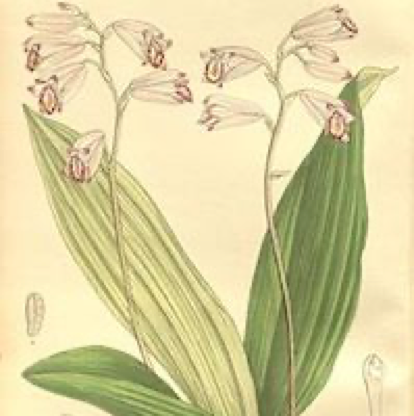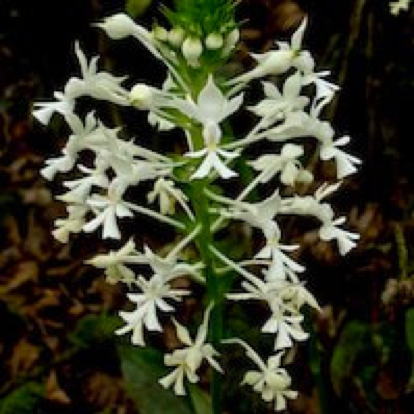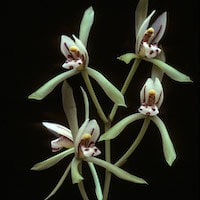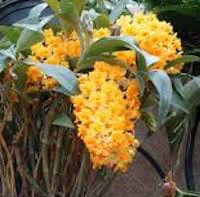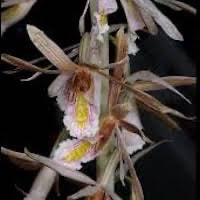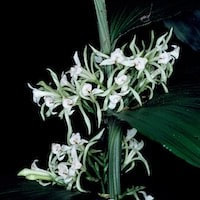WFL4- Women's Floral 4 - You are cherry sweet
|
Native Singaporean Orchid notes: Coelogyne Rochussenii
Coelogyne Rochussenii is a special orchid from Singapore used in the Floral 4 (Women) perfume workshop at Scentopia for team building. It blooms in winter, producing up to 40 fragrant flowers that open in the morning and close at night. The orchid’s sweet scent attracts pollinators and aids in its reproduction. It was rediscovered in Singapore and is now part of the local botanical heritage. The Monetary Authority of Singapore even featured it on a $5 silver coin, highlighting its importance and beauty.
|
Therapeutic Orchid notes:
|
Bletilla foliosa
Bletilla foliosa, also known as Xiaobaiji in Chinese and Bach cap or Hoa lan tia in Vietnamese, is an orchid found in Yunnan, Myanmar, and Thailand. Blooming from May to June, it produces beautiful flowers and is valued for its medicinal properties. Its astringent nature helps tighten tissues and promote wound healing, while it is also used as an embolic material to control bleeding or treat certain conditions. This orchid plays an important role in traditional medicine in both Chinese and Vietnamese practices. |
|
Calanthe triplicata syn. Calanthe veratrifolia R. Br. ex Ker Gawl.
Calanthe triplicata, also known as Calanthe veratrifolia, is an orchid with many names across different regions: Sanzhexiaji Lan in Chinese, Tsuru Ran in Japanese, Ueang Kao Tog in Thai, and various names in Indonesian regions. The plant’s leaves produce indigo, a blue dye. Traditionally, its roots are used to treat rheumatism, backache, and fractures, while other parts are used for diarrhea and toothaches. A 17th-century naturalist noted its sharp taste and medicinal uses, highlighting its cultural and therapeutic significance. |
|
Cymbidium lancifolium Hook.
Calanthe triplicata, also called Calanthe veratrifolia, is an orchid with various names like Sanzhexiaji Lan in Chinese and Tsuru Ran in Japanese. Its leaves produce indigo dye, and traditionally, the roots are used for treating rheumatism, back pain, and fractures, while other parts help with diarrhea and toothaches. A 17th-century naturalist noted its sharp taste and medicinal properties. This orchid has a rich cultural and therapeutic significance across different regions. |
|
Dendrobium densiflorum Lindl. Syn Dendrobium clavatum Roxb.
Dendrobium densiflorum, also called Dendrobium clavatum, is an orchid known by different names around Asia: Ueang Mon Kai Liam and Uang Min Khai Luang in Thai, Thy-tien in Vietnamese, Ta khun lone shwe in Myanmar, and Sungabha or Sungava in Nepali. Traditionally, its leaves are used in India to help heal bone fractures, while the pulp of its pseudobulbs is used in Nepal to treat skin issues like pimples and boils. These practices highlight its potential medicinal benefits, though professional medical advice is recommended for treatment. |
|
Eulophia dabia (D. Don) Hochr. syn. Eulophia campestris Wall ex Lindl.
Eulophia dabia (Eulophia campestris) is an orchid found from Afghanistan to south China. Known by many Indian names like Salibmisri and Charle-michhri, its tubers contain n-heacosyl alcohol and lupeol. The mucilage from the plant’s tubers can be used as a binder in medicine, releasing over 85% of drugs like paracetamol within 3 hours. In traditional medicine in India and Nepal, it’s used as a tonic and aphrodisiac, mixed with milk and spices for ailments like stomachaches and poor appetite. |
|
Corymborkis veratrifolia (Reinw.) Blume
Corymborkis veratrifolia, known as Guanhua Lan in Chinese and Kayu Hok in Semang, is an orchid found in China and Malaysia. This plant contains alkaloids, which are compounds with various biological effects. In traditional medicine, the leaf juice of Corymborkis veratrifolia is used as an emetic to induce vomiting in India, and in the British Solomon Islands, it helps treat foot cuts. Traditional uses can differ by culture, so it’s important to consult a healthcare professional before using it. |
Other scent note
Ylang-Ylang, Iris, French Jasmine, Daphne, Orris Root, Rose petals, Lily-of-the-Valley, Bromelia, Lilac, Kiwi Blossoms, Peony
Scentopia Library Reference ingredient
Gardenia - Check details at Scentopia's scent library
Download the guided mediation that works best with this Orchid fragrance oil
| women_floral_essential_oil_orchi_00004.mp3 | |
| File Size: | 114817 kb |
| File Type: | mp3 |

